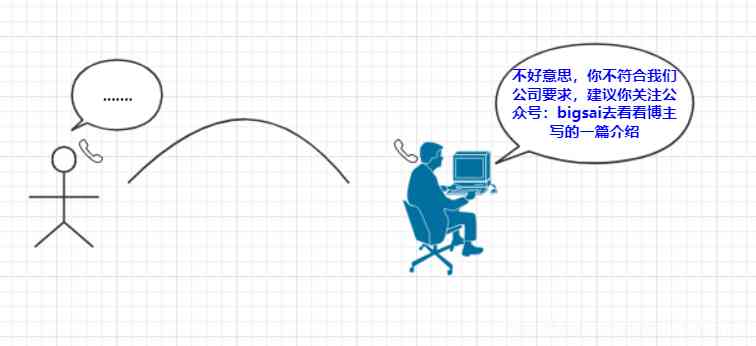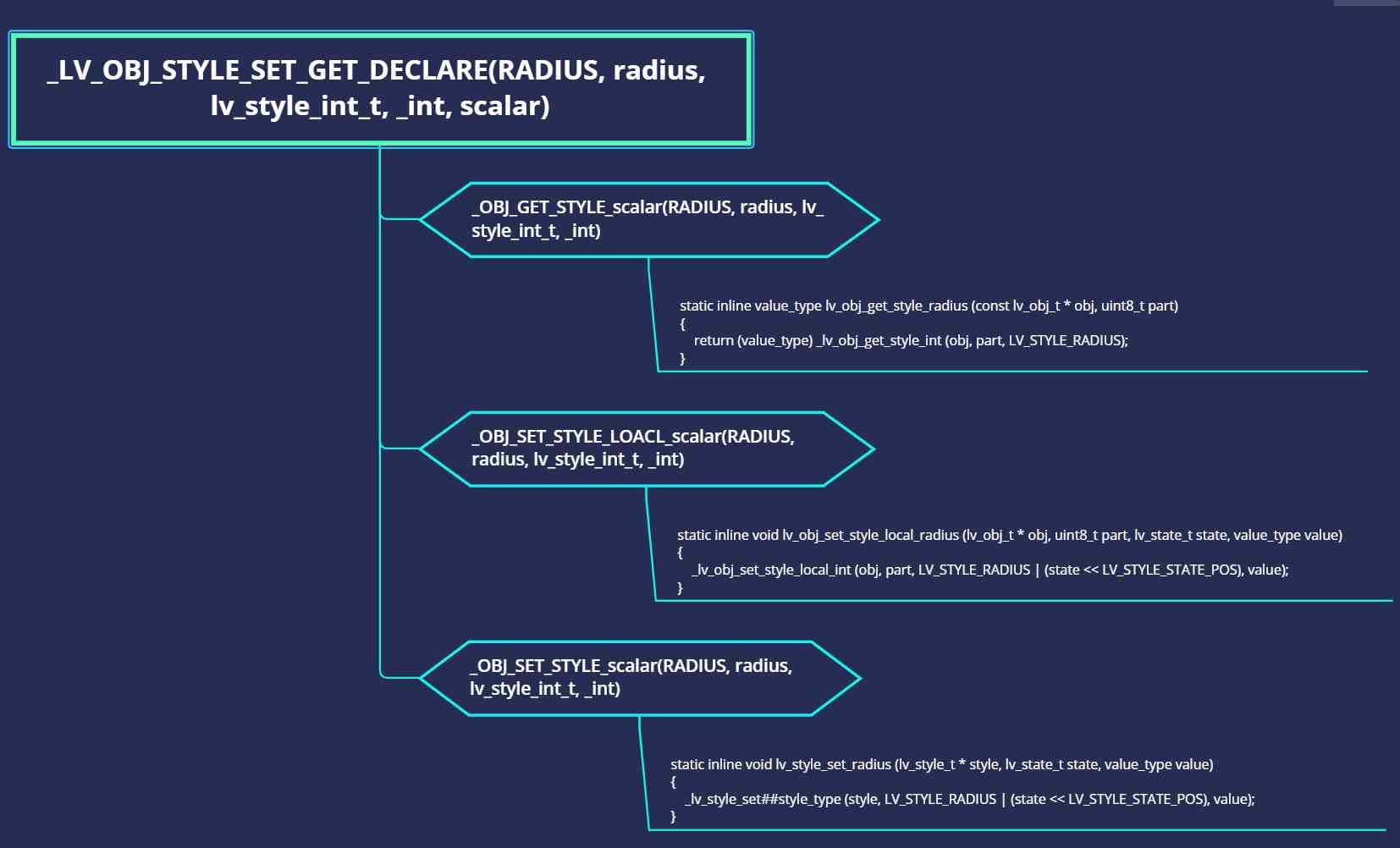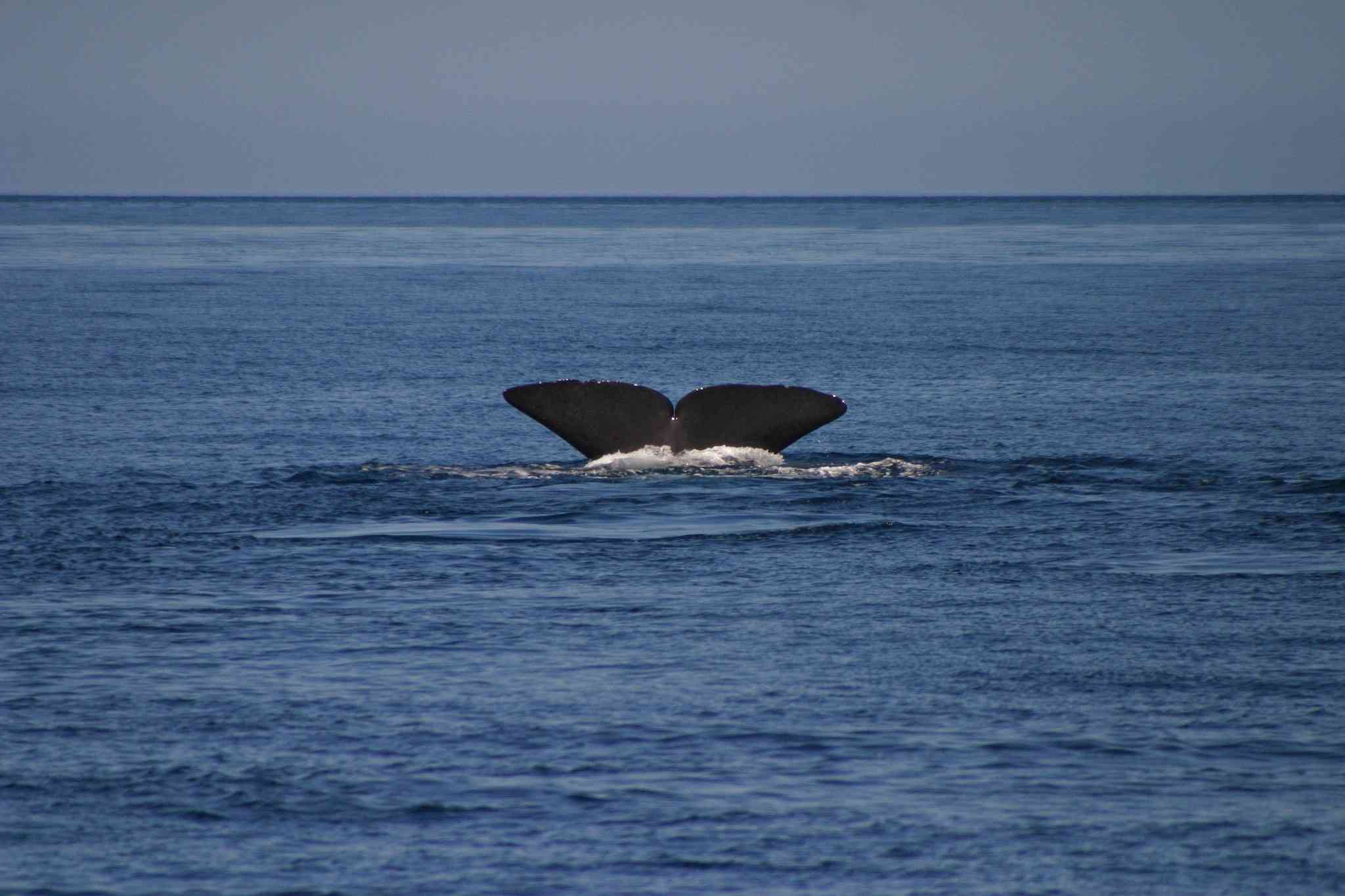
author |Lamothe Thibaud
compile |Flin
source |towardsdatascience
Using curvature integral and dynamic time warping , Let's delve into sperm whale recognition !
Preface
lately , We tried Capgemini Global data science challenge . I and Acores The whale research center works with , The challenge is to identify sperm whales , Using artificial intelligence to help save the lives of sperm whales .
In order to accomplish this task , We've collected thousands of pictures of whales from the past few years . In the training dataset , The average whale has 1.77 A picture , Many animals only appear once . therefore , The main idea is , Give a new picture , Find the closest to it from the existing data .
therefore , If the whale has been photographed , The researchers will be able to know when and where it was taken .
I am proud to announce , We finished the game with third place , We use Siam network It's a victory . however , Because there have been a lot of articles on this wonderful Architecture , Today I'm going to introduce a more interesting 、 A more novel way to solve this problem .
Method
from Weideman And so on , In their paper “ Curvature integral representation and matching algorithm for dolphin and whale recognition ” in , This is the key step of the method that I'm going to introduce today :
-
Tail extraction based on color analysis and contour detection
-
Curvature integral tail treatment (IC)
-
And dynamic time warping (DTW) Compare the tail of
disclaimer N°1: The prediction rate is not as good as Siam network , We have to explore other solutions . But the idea is very interesting , It's worth sharing and understanding .
disclaimer N°2: In many data science projects , Data preparation is the most difficult part . actually , To process the tail as a signal , The quality of the signal has to be very good . In this paper , We will take some time to understand all the necessary steps before signal processing .
Explore our dataset , Analyze the pictures
As stated in the introduction , We got thousands of pictures . At first glance , A whale is a whale . All of these pictures look like a blue background ( The sky and the sea ), There's a gray spot in the middle ( tail ).
After initial exploration , We started to distinguish between two different sperm whales , This is mainly due to the shape of the tail , We are convinced that this is crucial to our algorithm . What about the color ? Is there any interesting information in the pixel distribution ?

The correlation between the number of colors in each image ( Green and red – Blue and red – Green and blue )
Use Bokeh Visualization Library (https://bokeh.org/) , We quickly found that the colors in the image are highly correlated . therefore , We focus on the contours , Try to detect them by color change .
Tail extraction based on color filter
The first step in detecting the profile of the tail is to extract the tail from the sky and water . actually , This is the most difficult part of the process .
First , We use contour detection Algorithm . But because the sun is constantly changing from one lens to another , So the contrast has changed a lot , The results are always unsatisfactory .
By the way , It's interesting to see where image algorithms fail most , Because in most cases , The difference between the tail and the sea is obvious to humans .
That being the case , Let's delve into color analysis and contour extraction Automation .
Use color to extract the tail
Let's give each channel strength ( Red , green , Blue ) Draw a grayscale picture

Look at the three channels of a single image
As you can see above , This is true for most pictures , Less color in the middle , You can filter by pixel strength . Because the tail is usually gray , So they have almost the same number of each color (R = G = B), however , The sea and the sky are often blue , This makes the color ideal for filtering .
Let's see when only the blue value is retained , And only keep the blue value < Selected threshold (blue_value < SELECTED_THRESHOLD) What happens when the pixels are .
Selected threshold SELECTED_THRESHOLD The maximum value of is 255, Because it's the maximum pixel strength .

Through this series of pictures , We can believe that , It's easy to extract the tail . But how do I choose the filtering threshold ?
Here are the USES 10 To 170( Ten times ten ) As a result example of the threshold value of a single picture .
According to the intensity of the blue pixels , Apply... To an image 17 Different filters :
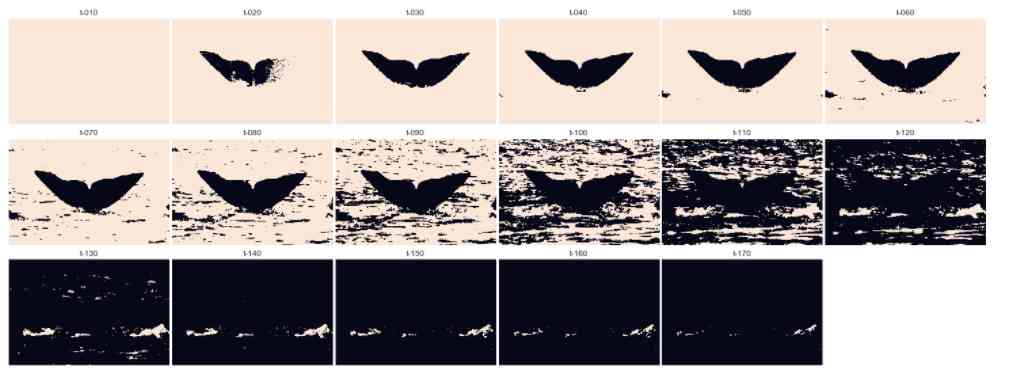
Here are some interesting things :
-
The threshold is very small ( about 10), The sea is gone , But the tail also disappeared
-
The threshold is very small ( about 20), Part of the tail disappeared
-
The threshold is not too high ( about 40), It's very well extracted , All the tails are not as blue as the threshold , But all the seas are bluer than the threshold .
-
At the intermediate threshold ( about 80) Under the circumstances , The tail remains intact , But we can only keep part of the ocean at first
-
At a threshold close to the median ( about 110) Under the circumstances , It's hard to tell the sea from the tail
-
At higher thresholds (>=140) Next , The tail completely disappeared . Even if the sea is blue enough , Cannot select through filter .
So here we are , And it seems obvious that SELECTED_THRESHOLD = 40 And Application filter blue_value < 40.
You can guess. , It's not easy . Given the light intensity of the image , The correct value for this image is 40. But it's a cliche too . By plotting all of these thresholds on random images , The threshold occurs at 10 To 130 Change between . So how to choose the right value ?
Use the bounding box to select the threshold
By looking at the front picture , We thought of something : The correct image with the correct threshold is the image with the largest white space on the outside and the largest area on the inside . And hope some of them are in ImageNet The trained neural network can locate the whale in the picture . We decided to use the ImageNet Class MobileNet.

Compared with the original picture , A batch of extracted tails with borders
That's a good idea . As shown below , We can position the tail very accurately in the picture . then , We can put “ The tail - Inside ” And “ The sea - external ” Separate .
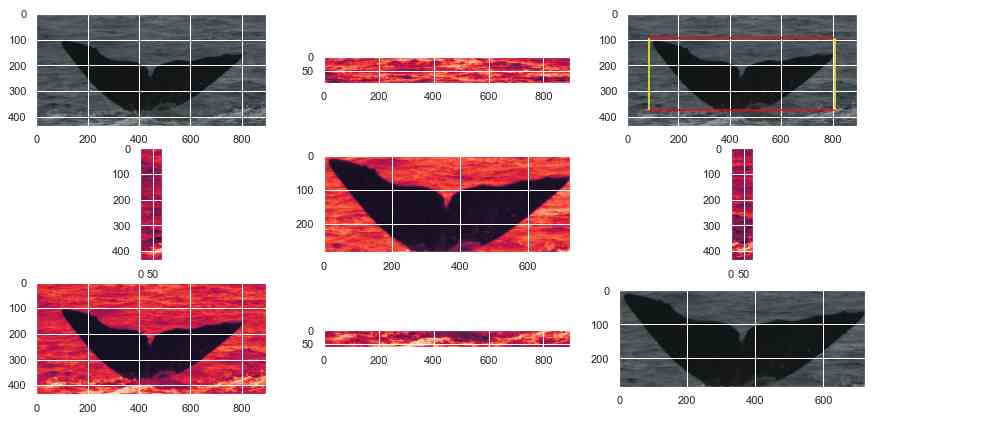
To better understand this separation , For each picture of the training set , We add the blue values of each pixel in the bounding box , And do the same for the pixels outside the frame .
then , Let's draw each picture on the diagram below , The internal results are reflected in X On the shaft , The external results are reflected in Y On the shaft . The blue line stands for X = Y. The meaning we can get from this graph is as follows : The further away you are offline , The easier the separation between the tail and the ocean .

Compare sperm whale images with blue pixel intensities inside and outside the bounding box
We try to apply filter thresholds based on the distance from the line , But it didn't produce any results . After several attempts , We can't do anything based on the color distribution of the picture , So decided to take a tough approach . In addition to looking at pictures and determining thresholds , We also apply 15 A filter , Analyze it , Then the best filter is automatically selected for further processing .
And then for a given picture , We will 15 Filters have been applied 15 Different values as thresholds . For each filter , We calculate the number of pixels inside and outside the bounding box ( After filtration , The pixel value is 0 or 1, There's no need to sum the strengths ). then , We normalize the results , Make the number independent of the size of the image , And draw the results on a graph .
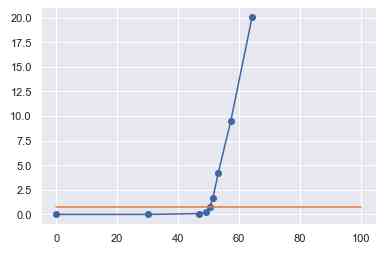
Single image and different filtering thresholds within the bounding box (X Axis ) And the outer frame (Y Axis ) The number of pixels .
For each picture , We get curves that are similar to the curves above , This is our mathematical transformation of the previous statement as the threshold evolves .
-
When the threshold is small , The tail and the sea are gone . There are no pixels inside or outside the tail
-
When the threshold increases , There's a tail , also X The value of the axis increases .
-
Until the threshold starts to appear in some parts of the ocean , And external value began to grow .
Use linear regression or derivative , Now it's easy to detect the right threshold : It is the threshold at the intersection of two lines of a graph .
Be careful : The orange line is y = y_of_the_selected_threshold
The last hint of tail extraction
Last , In order to get the best picture when extracting , When we figure out the best threshold (10,20,30,40,…,120,130,140,150) when , The assumption is 80. We are right. -5/+5 Value applies a filter . So we have three pictures : Blue < 75, Blue < 80, Blue < 85. Then we take three of these grid images (0 and 1) Sum up , And only keep the value of the resulting pixel equal to 2. This will serve as the final filter , Remove the noise from the tail . This kind of extraction effect is very good , We decided to apply it to all the pictures .
result
As a summary , Here are the assumptions we've made so far :
-
We can use the intensity of the blue pixels to distinguish the tail from the ocean
-
Before filtering , You need to find a threshold for each image
-
Using a bounding box is an effective way to find this threshold
After hours of work , We ended up with a very good tail extractor , It works well with different brightness , The weather , Ocean color , Tail color tail , And be able to view the most difficult pictures .
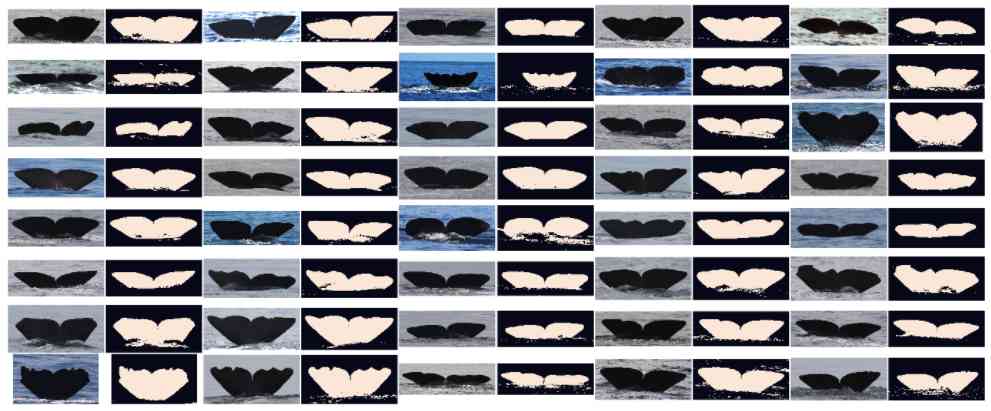
A batch of extracted tails are compared with the original image
Contour detection
Now the tail is in the picture , We do contour detection . exactly , To deal with tails in time series , We need to signal .
In this step , We can use OpenCV The contour detection algorithm of , But through the following two steps , It's going to look faster :
step 1: Use entropy to remove noise around the tail
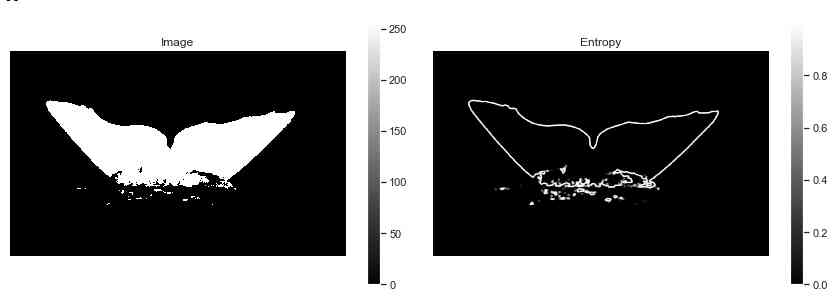
Use entropy change to keep only the outline of the extracted tail
step 2: Keep the highlight pixels of each column of pictures

The extracted tail contour detected after applying the entropy filter
This step is very simple , There's no complexity .
Curvature integral
By extracting the tail from the sea and getting the upper pixel of the image , We got the back edge of the tail as a signal . Now we have this , We have to deal with standardization . actually , All pictures are different in size or number of pixels . Besides , The distance to the sperm whale is not always the same , The orientation may change when shooting .
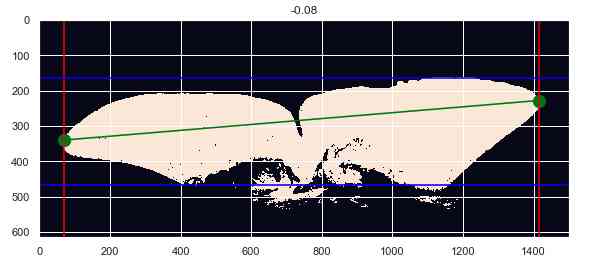
An example of tail orientation , There may be differences between two pictures of the same whale
For Standardization , We have to go along two axes . First , We decided to use each tail 300 Point to point comparison . Then we interpolate the shortest interpolation , And sample the longest one . secondly , We will 0 To 1 Normalization of all values between . This causes the signal to stack up , As shown in the figure below .
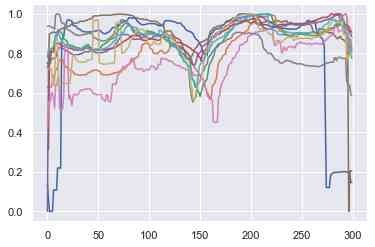
Scale signal superposition
To solve the problem of orientation , We use the curvature integral measure , This metric converts a signal into another signal by local evaluation .
As stated in the original paper :“ It captures the local shape information of each point along the trailing edge . For a given point on the trailing edge , We place a radius at this point r The circle of , Then find all the points on the trailing edge that lie within the circle .”
then , At each step , Pull our signal straight along the edge of the circle , So that it is inscribed as a square .
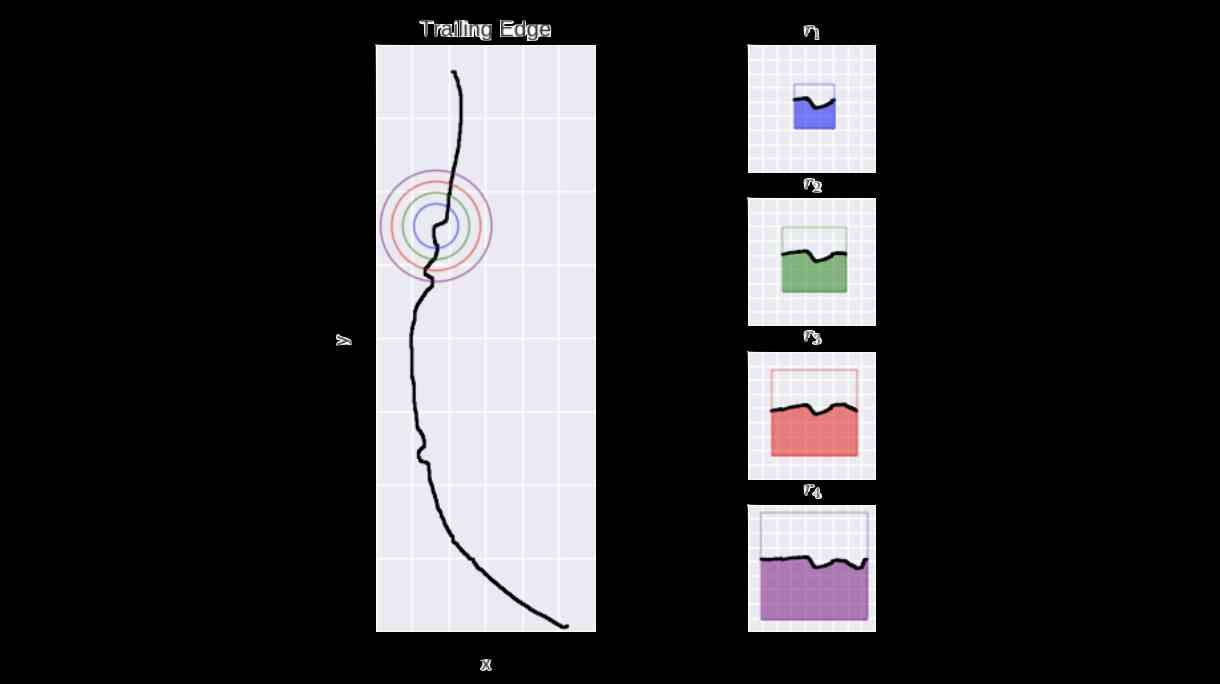
Curvature integral principle
Last , We define curvature as follows :
Curvature is the area under the curve to the total area of the square , This means that the curvature of the line is c = 0.5
therefore , We've got standardized signals , It's not about the distance between the whale and the photographer , It's not about the angle between the whale and the photographer , And it's not about the angle between the whale and the ocean .
then , For each training test picture , We are IC During the phase shift, the radii are created 5、10 and 15 Those signals in pixels . We store them , And for the last step : Comparison between time series .
In this paper , I will introduce the implementation of this algorithm . Once working , We can apply it to the trailing edge , And extract signals from environmental details . For a tail , The signal looks like this :
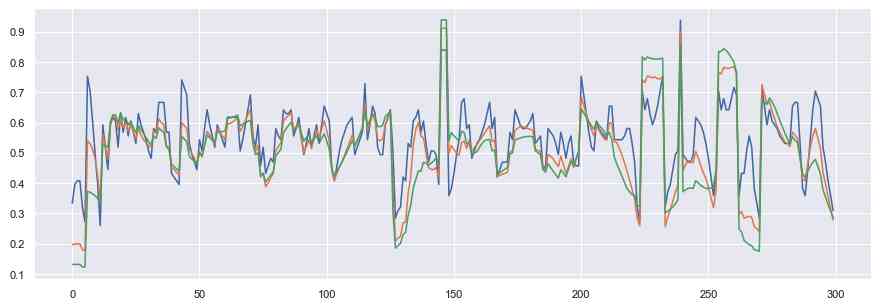
The curvature integral is applied to the case with 3 The tail edge of sperm whale with different radius values
Now? , Let's compare the signals !
Dynamic time regulation
Dynamic time regulation (DTW,https://en.wikipedia.org/wiki/Dynamic_time_warping) It is an algorithm that can find the best alignment between two time series . It is usually used to determine the similarity of time series , Classify and find the corresponding area between two time series .
Distance from Euclid ( finger It's the distance between two curves , Point by point ) contrary ,DTW Distance allows different parts of the curve to be linked . The principle of the algorithm is as follows :
Use 2 Curves , We created a distance matrix between two series , From the bottom left to the top right , Calculate the distance between two points Ai and Bi, Calculate the distance between the two points as follows :D(Ai, Bi) = |Ai — Bi] + min(D[i-1, j-1], D[i-1, j], D[i, j-1]).
When the distance matrix satisfies , We calculate the path with less weight from the upper right corner to the lower left corner . So , We choose the square with the smallest value in each step .
Last , The chosen path ( The green in the picture below ) Indication from sequence A Which data point corresponds to the sequence B Data points in .
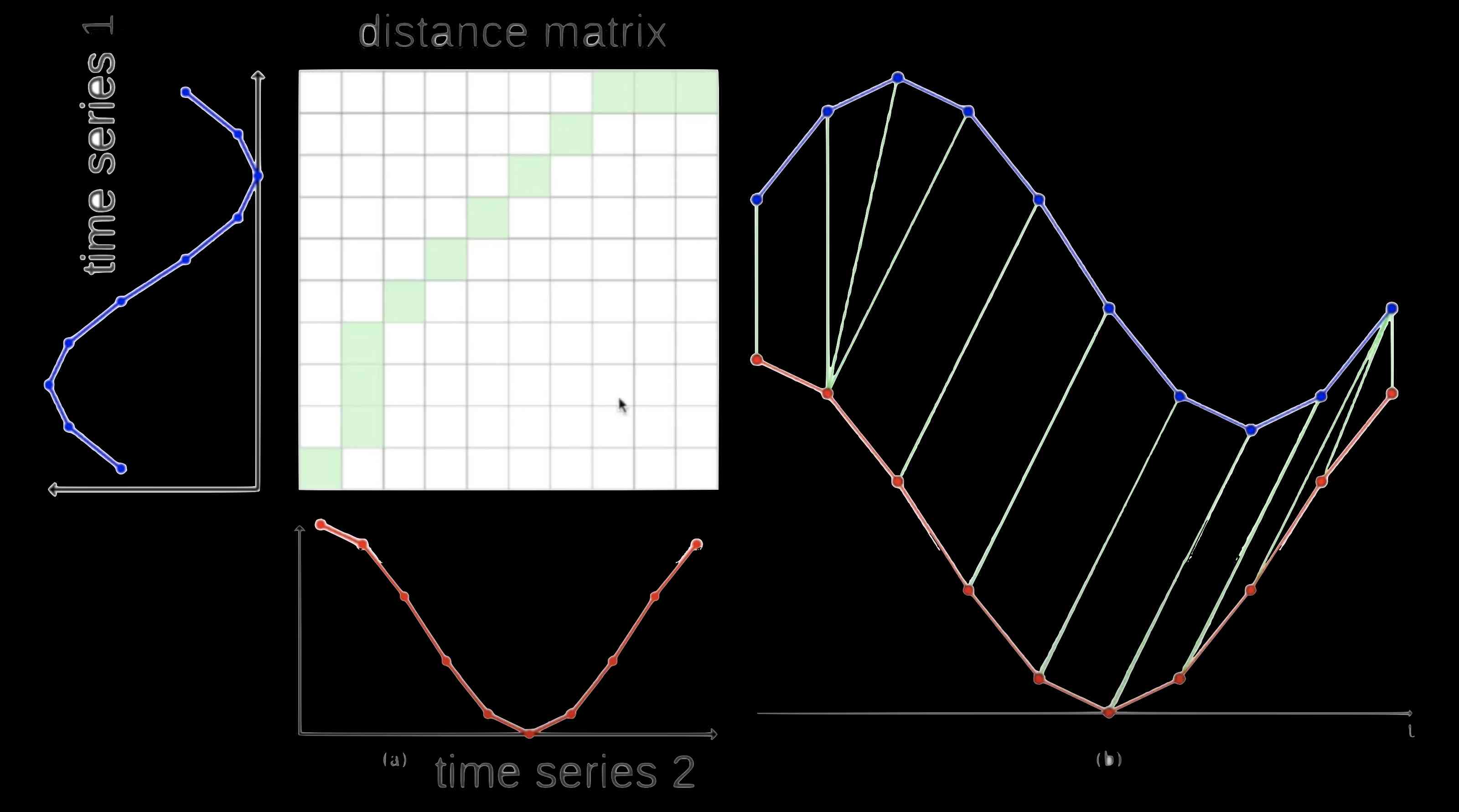
This kind of basic computing is very easy to implement . for example , This is one based on two sequences s And the function that creates the distance matrix t.
def dtw(s, t):
""" Computes the distance matrix between two time series
args: s and t are two numpy arrays of size (n, 1) and (m, 1)
"""
# Instanciate distance matrix
n, m = len(s), len(t)
dtw_matrix = np.zeros((n+1, m+1))
for i in range(n+1):
for j in range(m+1):
dtw_matrix[i, j] = np.inf
dtw_matrix[0, 0] = 0
# Compute distance matrix
for i in range(1, n+1):
for j in range(1, m+1):
cost = abs(s[i-1] - t[j-1])
last_min = np.min([
dtw_matrix[i-1, j],
dtw_matrix[i, j-1],
dtw_matrix[i-1, j-1]
])
dtw_matrix[i, j] = cost + last_min
return dtw_matrix
That being the case , Let's go back to our sperm whales ! Each tail of the dataset is converted to “ Integral curve signal ”, We calculated the distance between all the tails , To find the closest .
after , When a new picture is received , We have to get it through the whole preparation process : Use the tail of the blue filter to extract , Using entropy method for contour detection and using IC Perform contour conversion . It gave us a 300x1 The tensor of shape , Finally, we need to calculate the distance of the entire dataset . By the way , It takes time .
Sentence : The results are impressive ! When we have two pictures of the same whale , in the majority of cases , The two photos are the closest 40 Zhang , This is in 2000 The middle of the year is the best . however , As stated in the introduction , The result of using Siam network is better than this photo ( Pictures are usually in the nearest 5 Zhang Zhong ) ), Given the time of the game , We have to choose other methods in the investigation .
Reward : Processing half the tail and half the signal
We try to use the half tail , Suppose any of the following :
-
The tail is symmetrical , This will simplify the calculation .
-
The tail is asymmetrical , So you can compare it with the half tail .
Despite a lot of testing , But that doesn't give us very definite results . We don't think our separation is reliable enough : We will need more time to study the better separation that signal processing brings .
The last thought
After sending some tail fetches that are harder than we thought , Because of the color of the picture ( It's basically blue —— The sea and the sky ) And the brightness of the images in the dataset , We use two continuous processing methods for tail recognition .
First , Curvature integral is a method of normalizing the signal by looking at the local changes of the curve . then , We use dynamic time warping , This is the distance between two curves , Even if you move two curves, you may find similarities between them .
Unfortunately , It didn't turn out to be what I wanted , We can't continue to use the solution . Through more time and more effort , I'm confident that we can improve every step of the pipeline , To get a better model . I also enjoy working with the concepts mentioned in this article .
Through all the steps , Different ways to implement them and parameters , Monitoring all transitions is very challenging . Just as we have a roadmap , Each step has its own difficulties , Every little success is a victory , It opens up the next step . Very gratifying .
I find this method very interesting , And with the usual pre training CNN Completely different . I hope you also like the advantages of this approach in this article . If you have any questions , Please feel free to contact me
reference
-
We get from this paper IC + DTW Ideas :
-
Dynamic time regulation 1–0–1( secondary )
-
DTW python Realization
-
Kaggle Humpback whale identification competition
-
About this event Capgemini Webpage ( For people outside the company )
Link to the original text :https://towardsdatascience.com/whale-identification-by-processing-tails-as-time-series-6d8c928d4343
Welcome to join us AI Blog station :
http://panchuang.net/
sklearn Machine learning Chinese official documents :
http://sklearn123.com/
Welcome to pay attention to pan Chuang blog resource summary station :
http://docs.panchuang.net/


